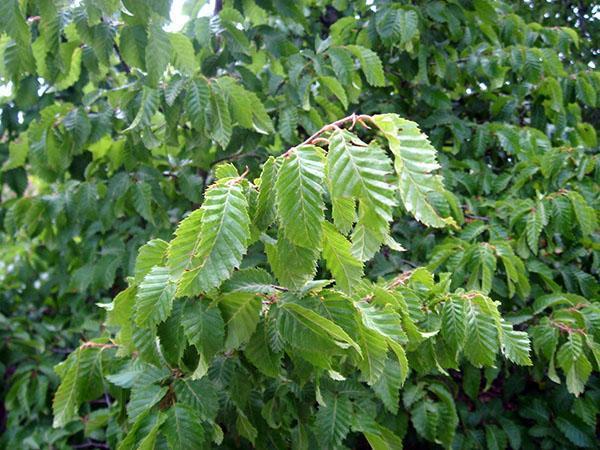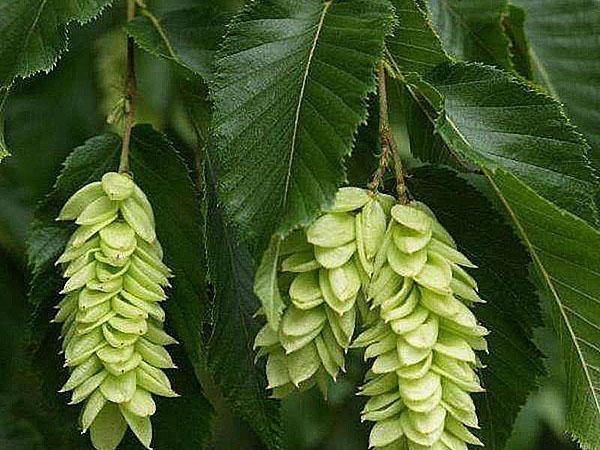The main thing about the healing properties of the hornbeam tree
 The hornbeam tree is a deciduous plant belonging to the Birch family. Sometimes it develops as a "bush". Despite the fact that the tree grows slowly, its dimensions are impressive: with a trunk diameter of 40-80 cm, the height can reach 30 meters. With all this, the plant lives for about 300 years.
The hornbeam tree is a deciduous plant belonging to the Birch family. Sometimes it develops as a "bush". Despite the fact that the tree grows slowly, its dimensions are impressive: with a trunk diameter of 40-80 cm, the height can reach 30 meters. With all this, the plant lives for about 300 years.
Description

It is easy to identify the hornbeam tree (photo and description below in detail) by its appearance. The bark on the trunks is gray and smooth. On some specimens it is covered with small cracks. There are also longitudinal ribs. In the process of growth, a dense crown of about 9 m in diameter is formed from thin branches and oval-shaped foliage with veins and a jagged edge. Hornbeam leaves are very decorative and reach 10 cm in size. In summer they are green, but with the arrival of autumn, the color changes to purple or yellow.
As for the root system, it is highly branched and extends superficially, giving the tree a high resistance to wind.
Hornbeam begins to bear fruit when it gets stronger. This is about 15-20 years later.
The plant is monoecious. Simultaneously with the foliage, female catkins bloom, which are then pollinated by the wind. After flowering, ligneous fruits with one seed are formed.
As for the conditions for good development, the tree prefers to grow on rich, loose calcareous soil. But the parameters of humidity depend on the variety: some hornbeams prefer a rather humid environment, others prefer a dry one.
The situation is similar with shade tolerance. In varieties that love the sun, practically no root shoots are formed, while in those that love the shade there are a great many.
Pests and diseases
The good news is that uninvited guests in the form of insects infect only sick and weakened plants. And then, you can only meet leaf or bark beetles.
Most often, the hornbeam tree is affected by cancerous growths, various rot that settle on the shoots. There is also the appearance of spots on the foliage. In case of detection of fungal diseases, the plant is treated with herbicides. If the crown is affected by spotting, then the entire plant is treated with a solution copper sulfate... The fallen leaves are collected and then burned.
As for the cancer of the trunk, which forms when a tree is damaged by a marsupial fungus with the further formation of a cancerous ulcer, in this case the plant cannot be saved. It is cut down and burned.
Application
 The main application of hornbeam is planting in home gardens or in parks as a bright accent. But if you look into antiquity, you can learn a lot of interesting things.
The main application of hornbeam is planting in home gardens or in parks as a bright accent. But if you look into antiquity, you can learn a lot of interesting things.
When burning, the wood does not form smoke. That is why it used to be often used in braziers at bakeries and pottery workshops.
The wood of the tree is often used in various industries:
- Strong handles for axes, shovels, rakes, knives, as well as bases for combs are made of wood. Cutting boards, floor coverings, parquet are also made from it.
- Due to its high strength and durability, wood has found recognition in the furniture industry. True, along with the advantages, there are a number of disadvantages. For example, the dependence of wood on environmental moisture makes it difficult to polish or cut a hornbeam product. Wood must be treated with special means to prevent rotting. As for painting, after the manipulations, no changes occur.
- The foliage of the tree is often used as animal feed.
- Due to the fact that the tree lends itself well to pruning, it is often planted in parks, for the improvement of squares, alleys. Moreover, specimens can be planted both singly and in group plantings.
- The bark is used in leather tanning.
- And due to its slow growth and the ability to keep the "haircut" for a long time, hornbeam is often used to create bonsai.
- There are many essential oils in the leaves and bark. Therefore, they are often used in cosmetology.
Essential components are also present in hornbeam fruits and, by the way, can be used for food.
Use in traditional medicine
 The hornbeam tree also found recognition in alternative medicine. So, healers use foliage, bark and even tree flowers in treatment. This is due to its rich chemical composition. So, the hornbeam crown contains: tannins, coumarins, bioflavonoids, aldehydes, gallic acid, caffeic acid. The seeds are rich in vegetable fats, and the bark contains a lot of essential oils and ascorbic acid. The juice is also rich in beneficial components such as sugars and organic acids.
The hornbeam tree also found recognition in alternative medicine. So, healers use foliage, bark and even tree flowers in treatment. This is due to its rich chemical composition. So, the hornbeam crown contains: tannins, coumarins, bioflavonoids, aldehydes, gallic acid, caffeic acid. The seeds are rich in vegetable fats, and the bark contains a lot of essential oils and ascorbic acid. The juice is also rich in beneficial components such as sugars and organic acids.
All these parts of the plant are used to create medicinal drugs that are used in the treatment of female infertility, neoplasms in the brain, diarrhea, and problems with the blood circulation in the brain. Also hornbeam is included in the fees used for termination of pregnancy.
The hornbeam may be a medicinal plant, but you must not forget that official medicine does not contain medicinal products with hornbeam. Therefore, you should be careful not to take medications without first consulting your doctor.
Here we met another interesting representative of the flora world. Give your plot some charm and plant a hornbeam. In addition, he has no special requirements for care.